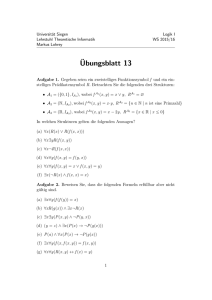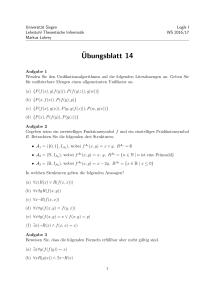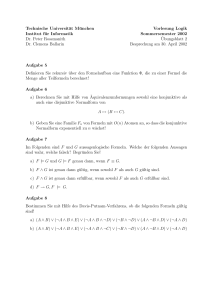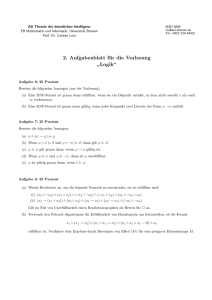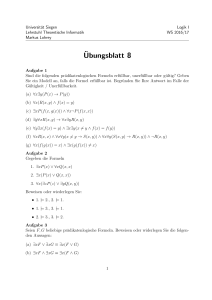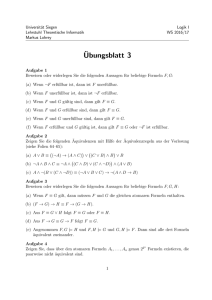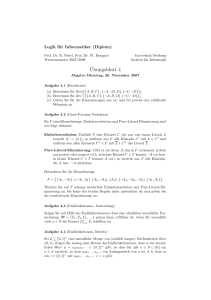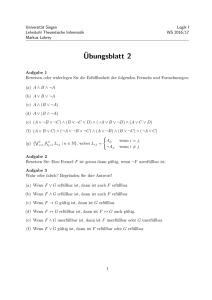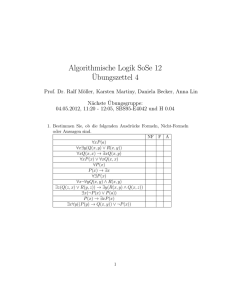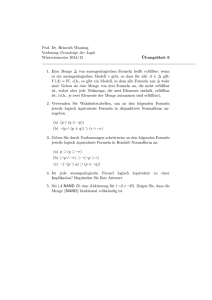UNIVERSITÄT DES SAARLANDES
Werbung
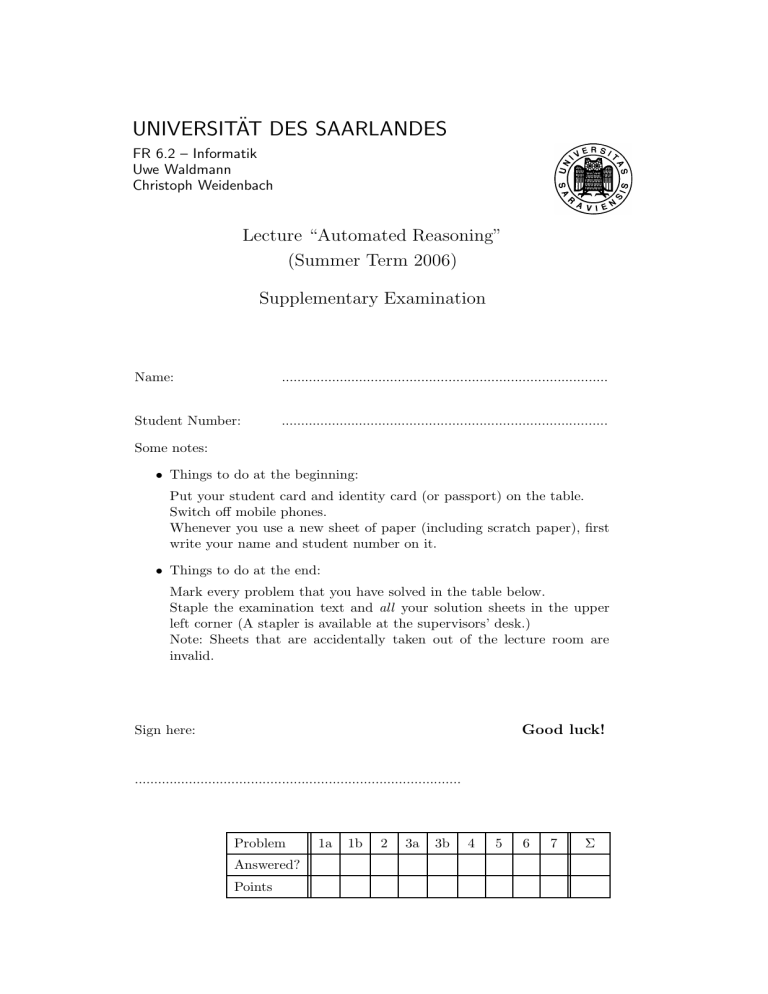
UNIVERSITÄT DES SAARLANDES
FR 6.2 – Informatik
Uwe Waldmann
Christoph Weidenbach
Lecture “Automated Reasoning”
(Summer Term 2006)
Supplementary Examination
Name:
....................................................................................
Student Number:
....................................................................................
Some notes:
• Things to do at the beginning:
Put your student card and identity card (or passport) on the table.
Switch off mobile phones.
Whenever you use a new sheet of paper (including scratch paper), first
write your name and student number on it.
• Things to do at the end:
Mark every problem that you have solved in the table below.
Staple the examination text and all your solution sheets in the upper
left corner (A stapler is available at the supervisors’ desk.)
Note: Sheets that are accidentally taken out of the lecture room are
invalid.
Good luck!
Sign here:
....................................................................................
Problem
Answered?
Points
1a
1b
2
3a
3b
4
5
6
7
Σ
Problem 1 (Propositional logic)
(7 + 7 = 14 points)
Part (a)
Prove the following statement: If F and G are propositional formulas, F → G
is valid, and G is not valid, then ¬(F ∨ G) is satisfiable.
Part (b)
Refute the following statement: If F , G, and H are propositional formulas,
F → G is satisfiable, and G → H is satisfiable, then F → H is satisfiable.
Problem 2 (CNF transformation)
(10 points)
Transform the following formula into CNF using Miniscoping:
∀x (r(x, x) → ∃z p(z)) ↔ ∃z (p(z) ∧ ∀x r(x, z))
Problem 3 (Herbrand interpretations)
(7 + 7 = 14 points)
Let Σ = (Ω, Π) with Ω = {b, c, f }, Π = {p}, where b and c have arity 0 and f
and p have arity 1.
Part (a)
How many different Herbrand interpretations over Σ do exist? Explain briefly.
Part (b)
How many different Herbrand models over Σ does the formula
∀x (p(x) → p(f (x))) ∧ ∀x (p(f (x)) → p(x))
have? Explain briefly.
Problem 4 (Tableaux)
(12 points)
Prove the formula below via a closed AMGU Tableau:
∀x ∃y ∀z (r(x, y) ∨ p(x) ∨ r(x, z)) → ∀x ∃y (r(x, y) ∨ p(x))
1
Problem 5 (Critical pairs, LPO)
(10 points)
Let Σ = (Ω, ∅) with Ω = {b, f, g, h, k} and let E be the following set of
equations:
{ g(f (x), x, b) ≈ f (g(x, x, y)),
h(f (h(x))) ≈ k(x),
g(h(z), b, z) ≈ g(z, f (b), z) }
Find a precedence > on Ω such that the lexicographic path ordering induced
by > has the following properties:
(i) every equation s ≈ t in E can be oriented into a rewrite rule s → t or
t → s whose left-hand side is strictly larger than the right-hand side;
(ii) the resulting set of rewrite rules has no non-trivial critical pairs.
Problem 6 (Superposition)
(10 points)
A clause C is a semantic tautology if C is valid. Prove that the problem
whether a clause is a semantic tautology can be decided using the superposition
calculus.
Hint: Prove first that every superposition inference between two ground unit
clauses is actually a simplification.
Problem 7 (Superposition)
(10 points)
Consider the clause C =
∨ s ≈ t where s ≈ t is strictly maximal in C
and s t. Prove that the conclusion of the positive superposition inference
between C and (a renamed copy of) C on the top position of s is redundant.
C0
2
Aufgabe 1 (Propositionale Logik)
(7 + 7 = 14 Punkte)
Teil (a)
Beweisen Sie die folgende Aussage: Falls F und G propositionale Formeln sind,
so daß F → G gültig ist und G nicht gültig ist, dann ist ¬(F ∨ G) erfüllbar.
Teil (b)
Widerlegen Sie die folgende Aussage: Falls F , G und H propositionale Formeln
sind und sowohl F → G als auch G → H erfüllbar ist, dann ist auch F → H
erfüllbar.
Aufgabe 2 (CNF-Transformation)
(10 Punkte)
Transformieren Sie die folgende Formel unter Verwendung von Miniscoping in
Klauselnormalform:
∀x (r(x, x) → ∃z p(z)) ↔ ∃z (p(z) ∧ ∀x r(x, z))
Aufgabe 3 (Herbrand-Interpretationen)
(7 + 7 = 14 Punkte)
Sei Σ = (Ω, Π) mit Ω = {b, c, f } und Π = {p}, wobei b und c die Stelligkeit 0
und f und p die Stelligkeit 1 besitzen.
Teil (a)
Wieviele verschiedenen Herbrand-Interpretationen über Σ gibt es? Erläutern
Sie kurz.
Teil (b)
Wieviele verschiedenen Herbrand-Modelle über Σ hat die folgende Formel?
∀x (p(x) → p(f (x))) ∧ ∀x (p(f (x)) → p(x))
Erläutern Sie kurz.
Aufgabe 4 (Tableaus)
(12 Punkte)
Beweisen Sie die folgende Formel mittels eines geschlossenen AMGU-Tableaus:
∀x ∃y ∀z (r(x, y) ∨ p(x) ∨ r(x, z)) → ∀x ∃y (r(x, y) ∨ p(x))
3
Aufgabe 5 (Kritische Paare, LPO)
(10 Punkte)
Sei Σ = (Ω, ∅) mit Ω = {b, f, g, h, k}, und sei E die folgende Gleichungsmenge:
{ g(f (x), x, b) ≈ f (g(x, x, y)),
h(f (h(x))) ≈ k(x),
g(h(z), b, z) ≈ g(z, f (b), z) }
Finden Sie eine Präzedenz > auf Ω, so daß die von > induzierte lexikographische Pfadordnung die folgenden Eigenschaften hat:
(i) jede Gleichung s ≈ t in E kann zu einer Termersetzungsregel s → t oder
t → s orientiert werden, deren linke Seite strikt größer als die rechte
Seite ist;
(ii) die resultierende Menge von Termersetzungsregeln hat keine nicht-trivialen kritischen Paare.
Aufgabe 6 (Superposition)
(10 Punkte)
Eine Klausel C heißt semantische Tautologie, falls C gültig ist. Beweisen Sie,
daß das Problem, ob eine Klausel eine semantische Tautologie ist, mittels des
Superpositionskalküls entschieden werden kann.
Hinweis: Zeigen Sie zunächst, daß jede Superpositionsinferenz zwischen zwei
Grundeinheitsklauseln (Grundklauseln mit nur einem Literal) eine Simplifikation ist.
Aufgabe 7 (Superposition)
(10 Punkte)
Sei C = C 0 ∨ s ≈ t eine Klausel, so daß s ≈ t strikt maximal in C ist und
s t. Beweisen Sie, daß die Konklusion der positiven Superpositionsinferenz
zwischen C und (einer umbenannten Kopie von) C an der Spitze von s redundant ist.
4
